Tom's Guide Verdict
Apple's Studio Display is a great companion to Macs and iPads thanks to its excellent camera, fantastic speaker setup and gorgeous 27-inch 5K screen. For non-Apple devices, it's an overly expensive 5K secondary display.
Pros
- +
Beautiful, bright 5K display
- +
Six-speaker array delivers remarkably good sound
- +
12MP ultrawide camera captures great images/video
- +
Elegant design
Cons
- -
No height adjustment by default
- -
Center Stage not much use on a deskbound monitor
Why you can trust Tom's Guide
Screen Size: 27 inches
Resolution: 5,120 x 2,880
Refresh Rate: 60 Hz
Inputs: 3x USB-C, 1x Thunderbolt 3
Dimensions: 24.5 x 18.8 x 6.6 inches (with stand, height tops out at 23 inches w/ optional height-adjustable stand)
The Apple Studio Display ($1,499 to start and sometimes found on sale for as little as $1,299) is here, and it looks fantastic. This is the first monitor Apple has launched since the Pro Display XDR ($4,999) in 2019, and the Studio Display delivers many of the same benefits in a smaller, more affordable form.
Like the Pro Display XDR, the Studio Display offers useful features for creative professionals, including a range of reference modes and P3 wide color gamut support. But it also has unique features that any Mac user can enjoy, like a killer (for a monitor) six-speaker sound system and a 12MP ultrawide camera that supports Apple's Center Stage feature, courtesy of an onboard A13 Bionic chip.
However, if you don't plug it into a compatible Mac or iPad the Studio Display loses a lot of its value. It can't be updated without hooking up a Mac to download the appropriate firmware, and even when you get it working with a Windows PC it's basically just an overly expensive 5K external display with a built-in camera and speakers.
That said, this is easily one of the best monitors for MacBook Pro owners seeking an external display. The Apple Studio display pairs really well with Apple's new desktop, so check out our Mac Studio review. I'd buy the Studio Display for myself if I was looking to build a MacBook-centric workspace; read on to see why.
(And if you're not sure what sets this display apart from Apple's pricier Pro Display XDR, check out our Apple Studio Display vs Pro Display XDR showdown for a blow-by-blow breakdown of which you should buy.)
Apple Studio Display review: Price and availability
- Price starts at $1,599
- Nano-texture glass, height adjustable stand are an extra $400 apiece
The Apple Studio Display has been out for a good while at this point. It launched at $1,599, though you can often find it going for $100-$200 cheaper than that these days.
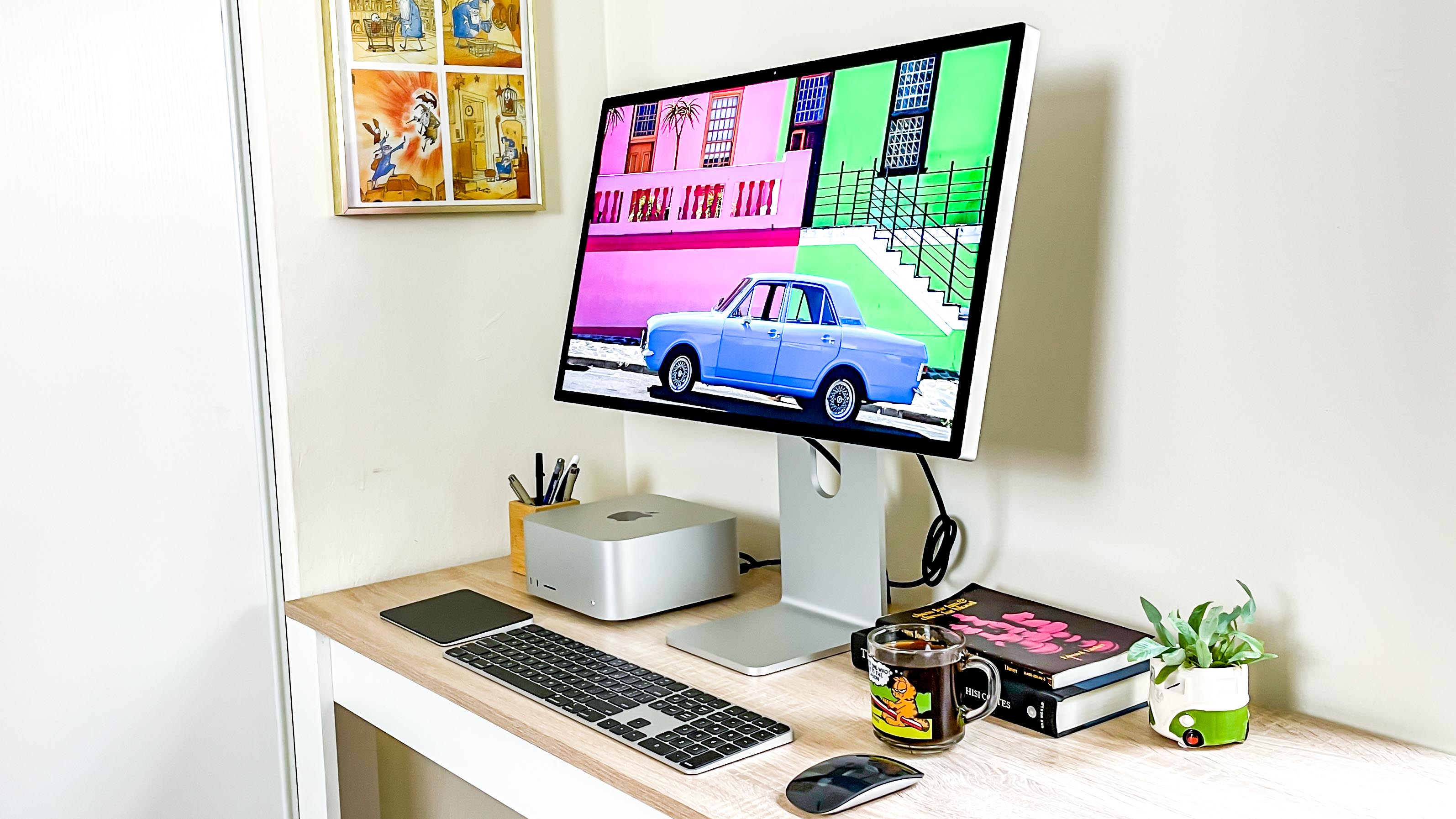
You can order the Display with either a stand or a VESA mount for wall- and monitor arm-mounting. However, the default stand only lets you tilt the display back and forward about 30 degrees, which makes it hard to work into an ergonomic workstation. You can pay extra to get a Studio Display with a tilt- and height-adjustable stand, but it'll cost you an extra $400.
Get instant access to breaking news, the hottest reviews, great deals and helpful tips.
I'm over 6 feet tall and thus quite grateful Apple chose to send us a Studio Display review unit with standard glass and the upgraded height-adjustable stand. You can buy the same display for $1,999, though frankly it's outrageous that Apple—a company that makes a show of prioritizing high-quality, well-designed products aimed at making customers' lives easier—can't manage to sell a display without charging $400 extra for the option to adjust the height.
Many of the best monitors on the market cost less yet have more options for height adjustment, which seems far more kind to customers and their spines. The design of the Studio Display continues to feel like an compromise that shouldn't exist on Apple's part.
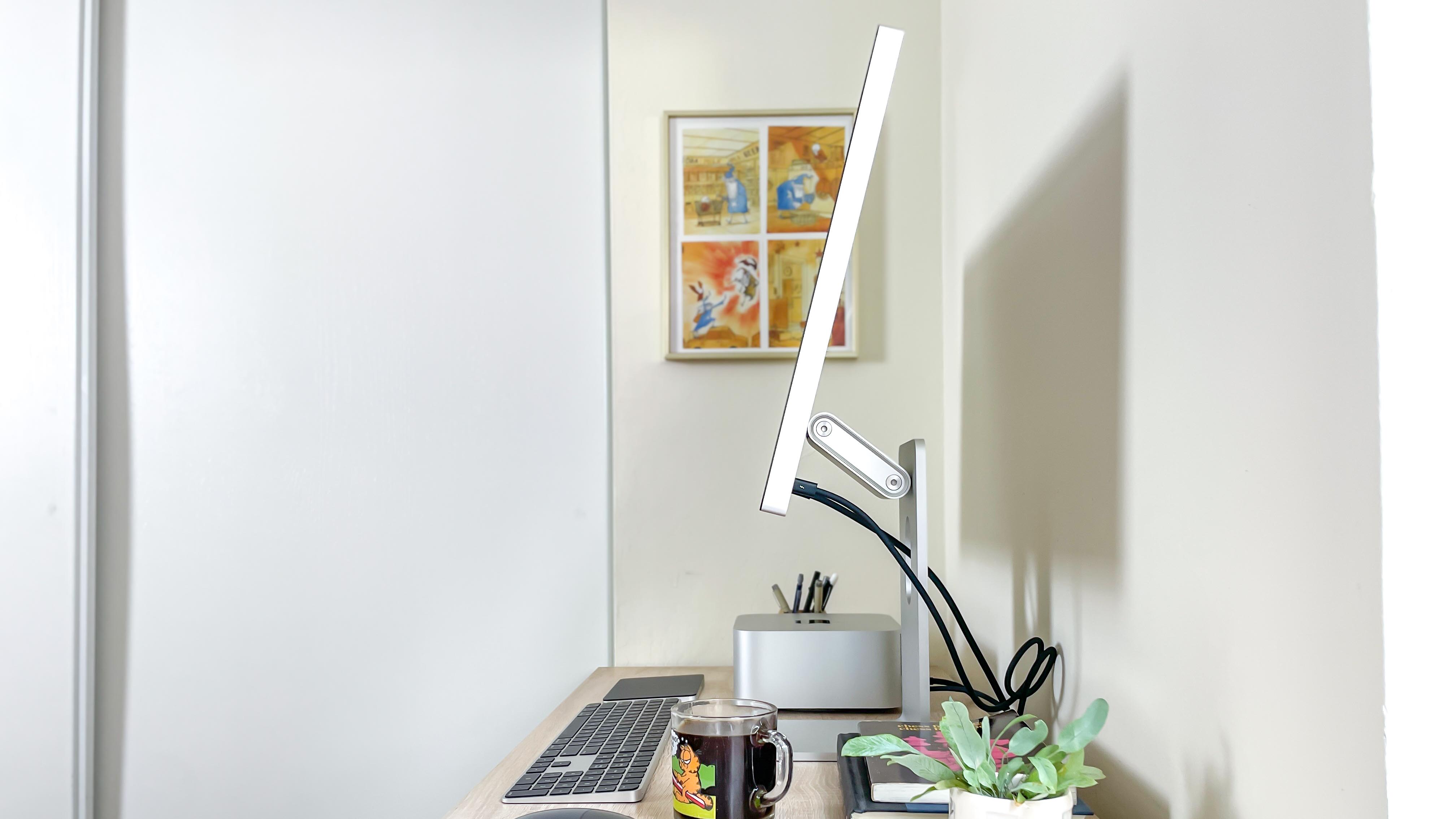
Also, you should know that Apple claims the Studio Display is only compatible with specific models of MacBook and iPad running macOS Monterey 12.3 or iPadOS 15.4 (or later). Here's the full list of compatible products, per Apple:
- Mac Studio (2022)
- 16-inch MacBook Pro (2019 or later)
- 14-inch MacBook Pro (2021)
- 13-inch MacBook Pro (2016 or later)
- 15-inch MacBook Pro (2016 or later)
- MacBook Air (2018 or later)
- Mac mini (2018 or later)
- Mac Pro (2019 or later)
- 24-inch iMac (2021)
- 27-inch iMac (2017 or later)
- 21.5-inch iMac (2017 or later)
- iMac Pro (2017)
- iPad Pro 12.9-inch (3rd generation or later)
- iPad Pro 11-inch
- iPad Air (5th generation)
Apple Studio Display review: Design
- Great design feels sturdy and looks good on a desk
- Useful port array; Thunderbolt 3 port can charge device driving the Display
Even the best monitors on the market don't offer features like a built-in 12MP ultrawide camera, a six-speaker sound system, a triple-mic array and an A13 Bionic chip. The Apple Studio Display packs all that into an elegant, professional-looking slab of screen and metal dominated by a 27-inch, 5K screen surrounded by a black bezel just over half an inch thick.
The Display measures 24.5 x 18.8 x 6.6 inches and weighs 13.9 pounds, though if you get the model with a height-adjustable stand it's about 3 pounds heavier (16.9 pounds) and you can adjust the height to anywhere between 18.8 and 23 inches. As much as I hate that you have to pay $400 for this seemingly basic feature, I have to admit that the mechanism for adjusting the Display's height up and down feels smooth and easy to use, yet sturdy enough to last for years.
The Studio's camera is embedded in the center of the top bezel, and unfortunately features no physical privacy shutter. There are also six speakers (4 force-cancelling woofers, 2 tweeters) built into the display that are capable of delivering spatial audio, as well as three microphones. Apple claims these are studio-quality mics that are good enough to make you not regret recording your next demo track in front of a monitor.
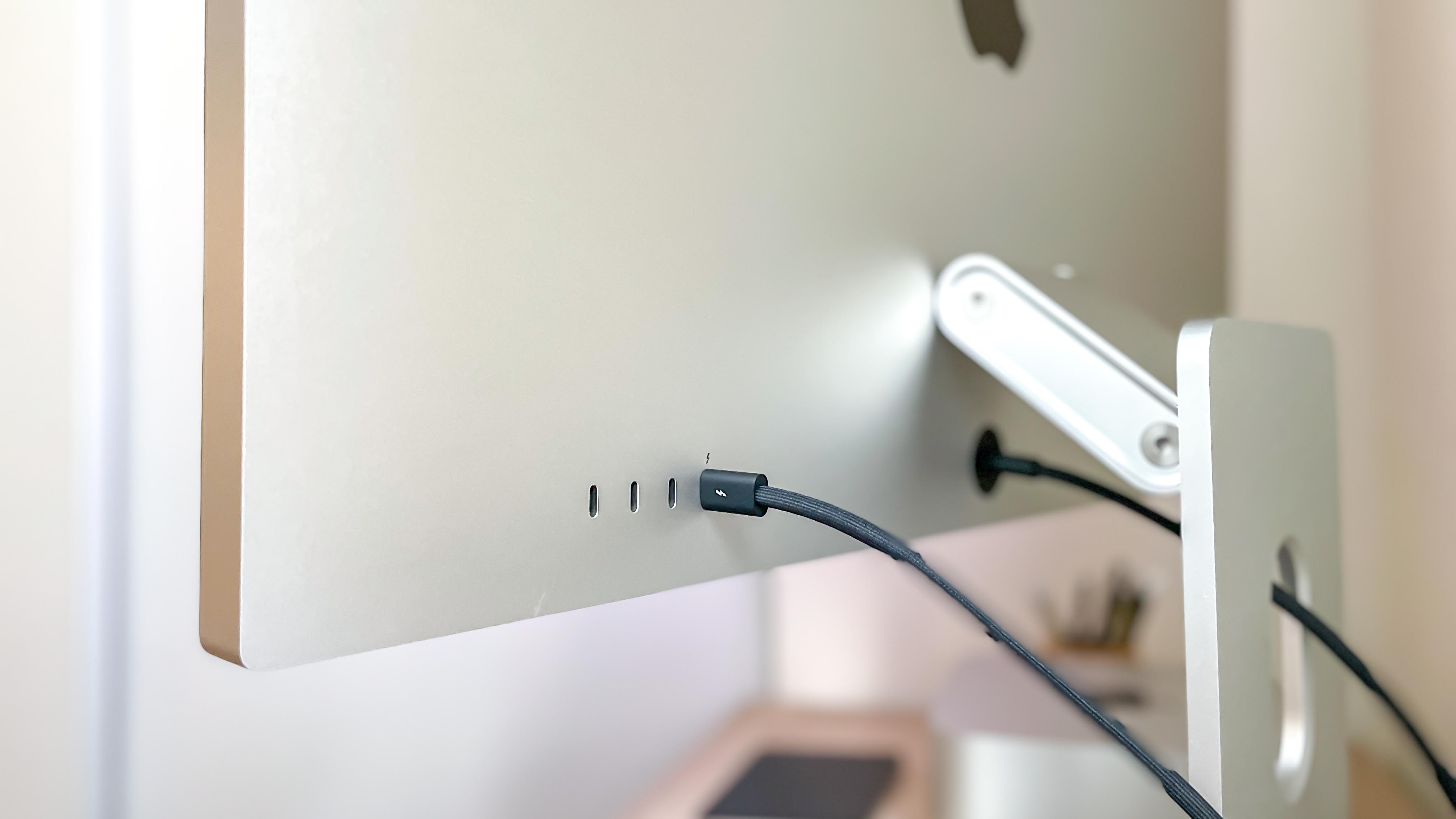
Around the back of the Studio Display you'll find a permanently attached power cable routed through a cutout in the stand, which is always a nice touch. On the lower-left side (looking at it from the rear) are three USB-C ports and one Thunderbolt 3 port, which you can use to drive the Studio Display from a compatible Mac, MacBook or iPad. It delivers power too, so if you hook up a MacBook or iPad it can charge the device while in use.
Apple Studio Display review: Screen
- 27-inch 5K display looks gorgeous
- Colors look accurate and pop off the screen, especially at high brightness levels
- Feels more like a TV than a monitor when streaming shows
The 27-inch 5K (5,120 x 2,880 pixels) screen on the Studio Display looks beautiful in person, displaying over 14.7 million pixels at a density of 218 ppi (pixels per inch).
The Display also supports the P3 wide color gamut and comes pre-configured with a range of reference modes that creatives can switch between as projects demand. These modes adjust settings like white point, gamma and color space, so unless you have a good reason to mess with them you're best off leaving it on the default setting. However, the Studio Display lacks support for the HDR Video reference mode, which makes sense since the Display can't display HDR (high dynamic range) content.
The Studio Display also can't match the 120Hz ProMotion adaptive refresh rate available on a number of other Apple products, including the 2021 MacBook Pros and iPad Pros. This is disappointing, as I'd started to get used to the smooth scrolling afforded by a faster refresh rate. And of course, if you want to display more than 60 frames per second (say, while playing a high-intensity game or editing high-fps footage), you won't be able to on the Studio Display.
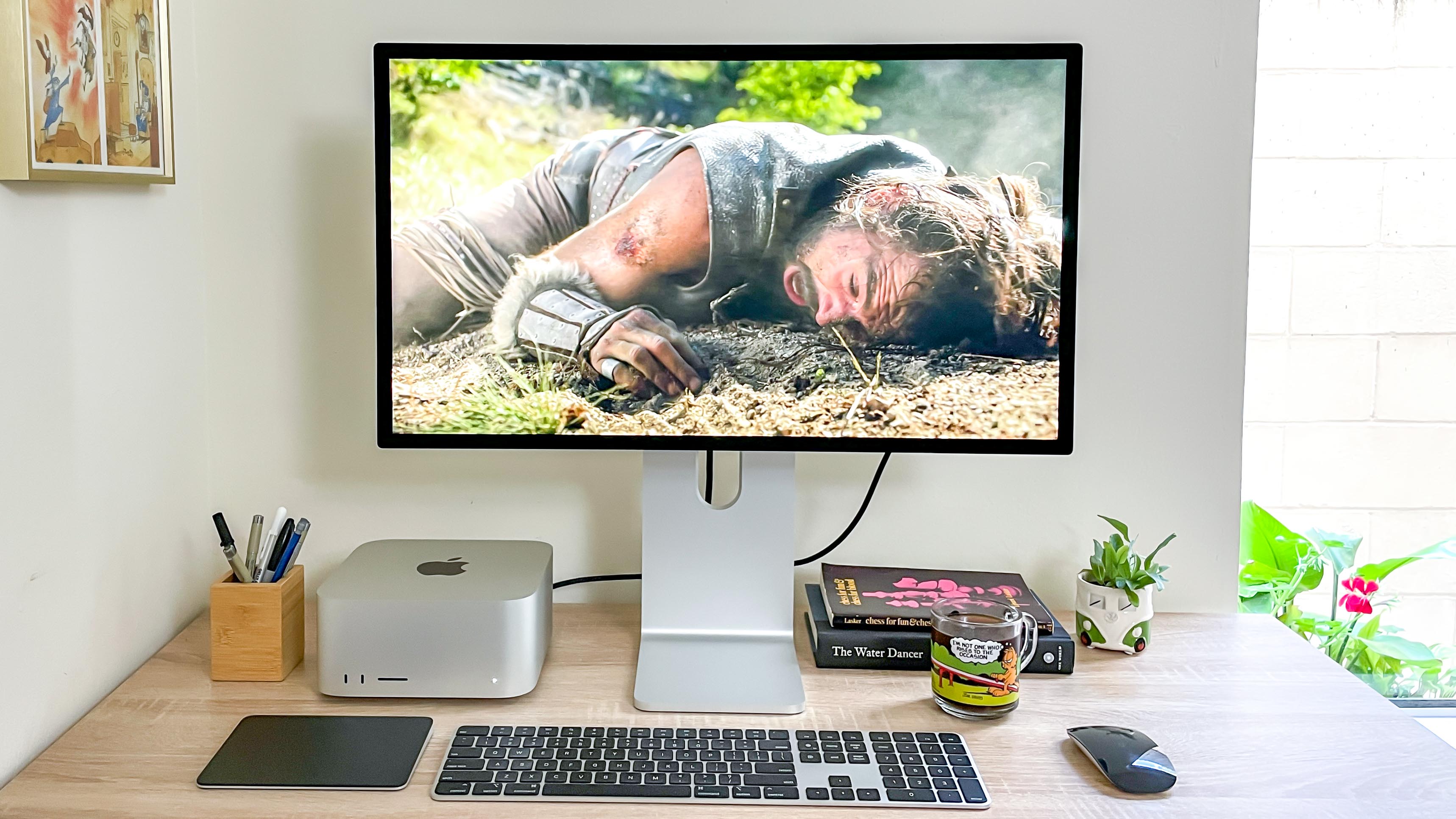
Now that we've had time to run the Studio Display through our testing lab, I can tell you that it in the default reference mode (P3-600 nits) it delivers 114.1% of the sRGB color gamut and 80.8% of the DCI-P3 gamut 100% is most accurate), with a Delta-E score of 0.21 (the closer to 0, the better).
If you're not sure what any of that means, don't worry—these details matter for pros doing detailed editing work where color accuracy matters. For the rest of us, these scores tell us that the Display is pretty color-accurate in the sRGB color space but not quite 100% capable of accurately displaying all colors in the broader DCI-P3 gamut. The low Delta-E score is good, as it suggests there's very little color distortion.
| Row 0 - Cell 0 | Studio Display | Pro DIsplay XDR |
| Average brightness | 518.4 nits | 466.8 nits |
| Max brightness | 563 nits (center) | 467 nits (center) |
| sRGB color gamut | 114.1% | 106.7% |
| DCI-P3 color gamut | 80.8% | 75.6% |
| Delta-E | 0,21 | 0.2 |
As far as brightness goes, the Studio Display achieves an average maximum brightness of 518.4 nits, peaking at 563 nits in the center of the screen. That's pretty close to Apple's promise that the Studio Display can achieve up to 600 nits of brightness, and it's actually brighter than the average max brightness we measured on Apple's Pro Display XDR (467 nits) when not viewing HDR content. Of course, the Pro Display XDR is capable of displaying HDR and thus can get quite a bit brighter under the right conditions, whereas the new Studio Display can't as it doesn't support HDR.
Still, in my experience it gets quite bright if you crank the brightness up, more than bright enough to use even in direct sunlight. Colors look accurate and really pop once you turn the brightness up. Games like Pathfinder: Wrath of the Righteous and Total War: Warhammer II look great running in 5K on this monitor, and when I streamed shows like The Wheel of Time I felt like I was watching them on a fancy TV, not my Mac. Of course, the high-quality sound coming out of the Display's speakers probably helped facilitate that illusion.
Apple Studio Display review: Speakers
- Six-speaker setup delivers excellent sound quality
- Bass feels impactful
- Spatial Audio sounds good, doesn't effectively replicate 360° sound
It's rare for us to devote a whole section of a monitor review to sound quality, but the Apple Studio Display is a rare breed of monitor. The six-speaker sound system built into the Display sounds amazing to my ears, with crisp, clear vocals and some surprisingly heavy bass. I listened through a few Mountain Goats albums and a smattering of other stuff on Spotify via the Display's speakers, and honestly they're the best sound system in my apartment right now.
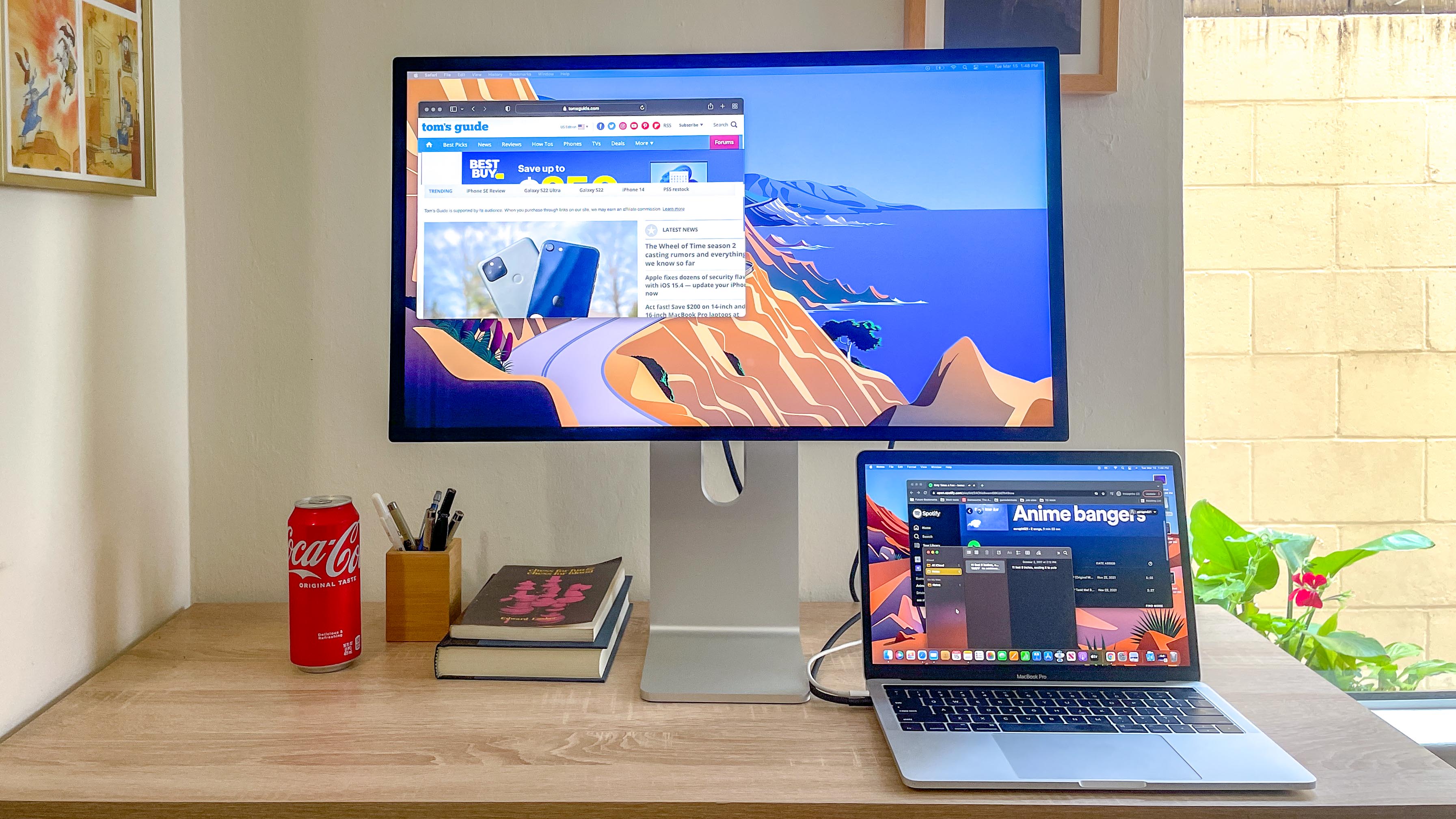
Perhaps that's not saying much since I'm no speakerhead (until now the best sound system in my apartment was my LG C1 OLED), so let me put it another way: the speakers are my favorite feature of the Studio Display. They're so good I regularly went and sat down in front of the Display just to listen to music, though you have to go easy on the volume because this thing gets loud. When I cranked it up to max I quickly heard my upstairs neighbor get up and walk out of the room. Maybe it was a coincidence — but I'll be on my best behavior around them the next few weeks, just in case.

The Studio Display's speaker array also supports Spatial Audio via Dolby Atmos, which basically means supported music and videos can sound like they're happening around you instead of just on the monitor. Apple's spatial audio tech is already available on a range of devices, and since Apple Music offers a good selection of tracks with spatial audio features I listened to a lot of those while testing the Display's spatial audio quality.
It's a neat feature that does make things sound more immersive, for lack of a better word, but it definitely didn't make me feel like I was hearing things all around me. Instead, the best way I can describe spatial audio is as though sound was originating from a point about six inches in front of the Display, rather than directly from it. Sound projects more, and feels deeper and more impactful, but even when I was watching a live visualization of how specific parts of a track were "moving" around behind my head, I couldn't trick myself into hearing the sound as though it was actually coming from behind me.
Apple Studio Display review: Webcam
- 12MP ultrawide camera captures great images and video
- Center Stage is neat to have on a monitor but not that useful
The 12MP ultrawide camera built into the top bezel of the Studio Display is excellent, and I was quite happy with the quality of both the images and video it captured of me during the review process. That's a rare thing for me to say about any webcam, but it's not a rare thing to say about an iPad camera, which is effectively what's built into the Studio Display since it has the same camera as the recently-released iPad Air (2022).
Like the iPad Air (and all modern iPads) the Studio Display also supports Apple's Center Stage feature, which intelligently crops and zooms the camera during video calls to keep you in frame as you move around. The Studio Display can do this thanks to its ultrawide camera and onboard A13 Bionic chip, which handles the necessary processing.
I've used Center Stage a few times now on various Apple devices, and it's a cool feature that you really don't need to care about at all unless you spend a lot of time moving around on video calls. On iPads it seems a little more useful since the camera is on a portable device you can set up for wide shots or to show specific scenes or processes (say, while walking a family member through a recipe); on the Studio Display it feels a bit less useful, just because I rarely found a good reason to walk around in front of my monitor during video calls.
After the Apple Studio Display's release, some users complained of issues with image quality shot by the webcam. Apple said it would release a firmware update to address the issue, and that update is now out in beta form, as of this writing. Having tested the firmware, we think there's an improvement to Apple Studio Display image quality, though not substantial enough for most people to nice.
Apple Studio Display review: Interface
- No interface to speak of; this monitor's a brick without a device to drive it
- Requires a Mac to update firmware
We typically like to give you a heads-up about how navigable and useful a monitor's interface is, but Apple's Studio Display doesn't have one. In fact, it has no physical interface to speak of: no buttons or knobs, not even a switch to turn it on. When you plug it in to an outlet you may see it briefly flicker to life and display a "..." symbol as it searches for connected devices, but it will otherwise stay dormant.
The only way to interface with the Studio Display is to plug a compatible device in and switch it on, at which point the Studio Display powers on as well. It doesn't just have to be an Apple device, either: I was able to plug an Asus ROG Zephyrus G14 gaming laptop into the Studio Display via USB-C and use Apple's monitor as a secondary display in Windows 11 with little trouble.
Note, however, that Apple says the Studio Display must be connected to a Mac in order to download and install firmware updates.
Apple Studio Display review: Verdict
The Studio Display is a great monitor, one that delivers a lot of the value of Apple's $5,000 Pro Display XDR in a much more affordable package. With its excellent camera, fantastic speaker setup and gorgeous 27-inch 5K screen, this is easily one of the best monitors for MacBook Pro owners seeking an external display.
However, if you plan to use it with non-Apple computers the Studio Display loses a lot of its value. Despite its onboard A13 Bionic chip it's pretty helpless without a computer to drive it, and if that computer isn't running macOS or iPadOS you'll have a hard time using the Display to full effect. When it's not plugged into compatible Apple hardware, the Studio Display is relegated to being an overly expensive secondary display.
But if you're a Mac user, this Display is made for you. I think it's well worth the asking price, though I dearly wish Apple didn't charge so much extra for the convenience of being able to adjust it up or down a few inches.

Alex Wawro is a lifelong tech and games enthusiast with more than a decade of experience covering both for outlets like Game Developer, Black Hat, and PC World magazine. A lifelong PC builder, he currently serves as a senior editor at Tom's Guide covering all things computing, from laptops and desktops to keyboards and mice.

